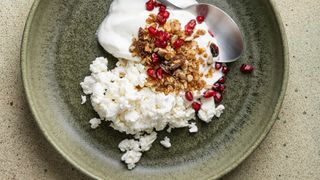These 2 small lifestyle changes can help keep your sugar levels stable every day, study says
Wondering how to keep blood sugar levels stable and stop feeling tired after lunch? This study might have the answer

We’ve all had days where we’ve not managed to have breakfast and have felt a little bit shaky or sweaty. These symptoms can be caused by low blood sugar, which is common first thing in the morning.
Our blood glucose levels rise and fall naturally throughout the day, but keeping them generally stable with balanced, healthy meals is important for our overall wellbeing. Fluctuating blood sugar levels can lead to anxiety, tiredness, dizziness, and loss of concentration, and longer-term health issues if this happens over time.
Unless you’ve been diagnosed with diabetes or are tracking your glucose levels for fitness optimisation, it's normal to have no idea what your blood sugar levels are doing and whether that's affecting how you feel. A new study has found that small changes to your diet and exercise routine can help keep your levels balanced throughout the week.
How to keep blood sugar levels stable
Published in Medicine & Science in Sports & Exercise, the study found that eating high-protein foods for breakfast and doing high-intensity cardio exercise twice a week, with endurance sessions on the other days, could help keep your blood sugar levels stable.
As your body becomes better at using oxygen, it also gets more efficient at oxidising glucose. Glucose, often referred to as ' blood sugar' when it's in the body, is the body's primary energy source and is made from carbohydrates in our food. We need it to fuel our exercise, and in return, exercise helps our bodies stay balanced.
The experts also found that maintaining consistent sleep and reducing stress have a positive impact on blood sugar levels.
The study, carried out in collaboration with fitness platform Les Mills, had participants wear a glucose monitor for two weeks while maintaining their typical routines, tracking data related to their training sessions, daily meals, sleep and emotions.
Sign up for the woman&home newsletter
Sign up to our free daily email for the latest royal and entertainment news, interesting opinion, expert advice on styling and beauty trends, and no-nonsense guides to the health and wellness questions you want answered.
The researchers found that a breakfast with at least 10g of protein reduced the risk of glucose variability. This could be a serving of Greek yoghurt with some nuts and seeds or foods such as eggs or cottage cheese.
The team also found that adding 20-minute low-intensity activities after meals could help manage blood sugar levels.
Lead researcher Dr Jinger Gottschall, from the University of Colorado, says: "We’re seeing growing interest in glucose tracking for health reasons beyond diabetes. Many people are currently unsure about what constitutes a healthy glucose variability, but it’s vital to understand how lifestyle habits enhance frequent fluctuations in glucose levels and the long-term consequences associated with them.
“The key benefit of this research is that it provides manageable, actionable steps that can be incorporated into daily life to reduce glucose variability – whether or not you have access to a tracking device. We know data tracking can be overwhelming, so instead, we want to demonstrate that small adjustments – such as frequent cardio and increasing protein intake – can make a significant difference.”
Les Mills' Bryce Hastings, the head of research, says: "Exercise plays a key role in maintaining glucose health because it helps regulate blood sugar naturally and improves overall metabolic health. These findings offer tangible insights into exercise and lifestyle choices that help reduce glucose variability.”
Disclaimer
You should speak to your doctor if you have any concerns about your blood sugar levels. This article is for general interest and is not intended to suggest a course of action that might be suitable for you. Always consult a licensed healthcare professional before making decisions concerning your health and wellbeing.

What are high-protein foods?
- Lean meats, like beef sirloin
- Poultry, such as chicken and turkey
- Fish, especially sardines, anchovies, and mackerel
- Eggs
- Nuts, especially almonds
- Dairy, like Greek yogurt and cottage cheese
- Beans
- Chickpeas
- Edamame
- Lentils
- Quinoa
- Tofu
What is high-intensity exercise?
You'll know you're doing high-intensity exercise when you're feeling very breathless, sweating, and your heart rate is at 80 to 95% of your maximum heart rate (220 minus your age). It's also often high-impact, meaning you'll feel it on your joints, and only done for a short period.
This includes activities like sprinting as part of a treadmill workout or on a stationary bike, skipping, and some types of strength training.
However, if you're used to doing high-intensity exercise, consult your doctor before starting a new program. It's not suitable for everyone.
What is endurance exercise?
Endurance exercise is lower-intensity exercise that increases your breathing and heart rate, but not as much. It includes exercises like walking, light running, swimming, cycling, and other types of strength training.
You should be able to maintain a comfortable pace for a longer amount of time - upwards of 20 minutes.
That could be walking 20 minutes or running 20 minutes, either one counts as endurance exercise.
If you're new to exercise, start small - try doing 10 to 15 minutes of exercise every day, and you'll see your fitness slowly start to improve.

Kat Storr has been a digital journalist for over 15 years after starting her career at Sky News, where she covered everything from world events to royal babies and celebrity deaths. After going freelance eight years ago, she now focuses on women's health and fitness content, writing across a range of UK publications.
From perimenopause to the latest fitness trends, Kat loves researching and writing about it all. She's happy to give any fitness challenge a go and speaks to experts about wellbeing issues affecting people every day.
-
 The White Company just launched an inspirational collection of affordable luxury home essentials - my basket is full
The White Company just launched an inspirational collection of affordable luxury home essentials - my basket is fullthe White Company's Summer collection is packed with outdoor dining essentials, from plush cushions to embroidered runners, here are our favourites.
By Laura Honey Published
-
 Queen Letizia’s maxi skirt and kitten heels combination is the comfy spring outfit formula you should try
Queen Letizia’s maxi skirt and kitten heels combination is the comfy spring outfit formula you should tryQueen Letizia of Spain gave a masterclass in easy spring styling with her maxi skirt and kitten heels combination - we'll be using her outfit formula that's effortlessly elegant and super comfortable too.
By Charlie Elizabeth Culverhouse Published
